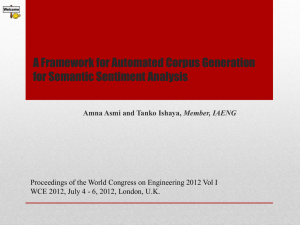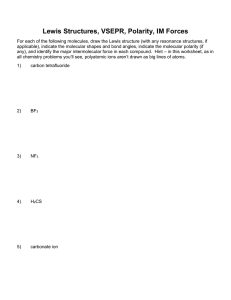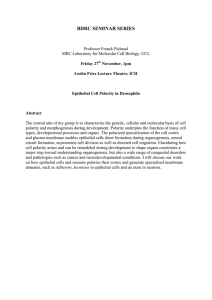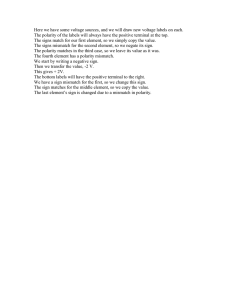Sentiment Classification Using the Meaning of Words
advertisement
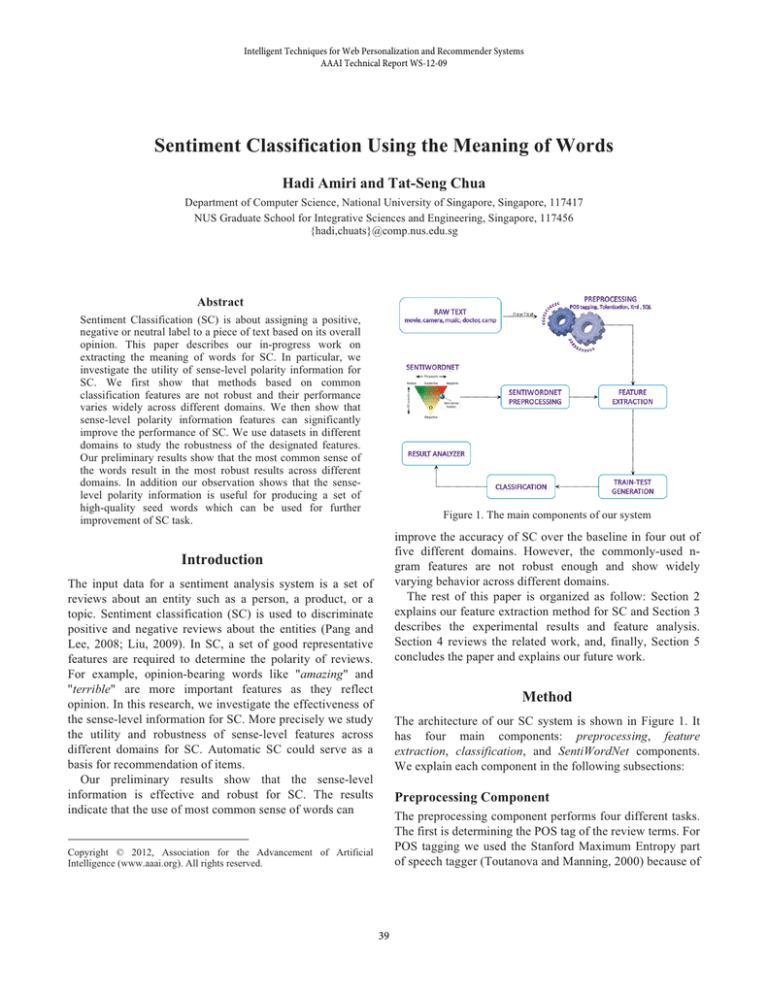
Intelligent Techniques for Web Personalization and Recommender Systems
AAAI Technical Report WS-12-09
Sentiment Classification Using the Meaning of Words
Hadi Amiri and Tat-Seng Chua
Department of Computer Science, National University of Singapore, Singapore, 117417
NUS Graduate School for Integrative Sciences and Engineering, Singapore, 117456
{hadi,chuats}@comp.nus.edu.sg
Abstract
Sentiment Classification (SC) is about assigning a positive,
negative or neutral label to a piece of text based on its overall
opinion. This paper describes our in-progress work on
extracting the meaning of words for SC. In particular, we
investigate the utility of sense-level polarity information for
SC. We first show that methods based on common
classification features are not robust and their performance
varies widely across different domains. We then show that
sense-level polarity information features can significantly
improve the performance of SC. We use datasets in different
domains to study the robustness of the designated features.
Our preliminary results show that the most common sense of
the words result in the most robust results across different
domains. In addition our observation shows that the senselevel polarity information is useful for producing a set of
high-quality seed words which can be used for further
improvement of SC task.
Figure 1. The main components of our system
improve the accuracy of SC over the baseline in four out of
five different domains. However, the commonly-used ngram features are not robust enough and show widely
varying behavior across different domains.
The rest of this paper is organized as follow: Section 2
explains our feature extraction method for SC and Section 3
describes the experimental results and feature analysis.
Section 4 reviews the related work, and, finally, Section 5
concludes the paper and explains our future work.
Introduction
The input data for a sentiment analysis system is a set of
reviews about an entity such as a person, a product, or a
topic. Sentiment classification (SC) is used to discriminate
positive and negative reviews about the entities (Pang and
Lee, 2008; Liu, 2009). In SC, a set of good representative
features are required to determine the polarity of reviews.
For example, opinion-bearing words like "amazing" and
"terrible" are more important features as they reflect
opinion. In this research, we investigate the effectiveness of
the sense-level information for SC. More precisely we study
the utility and robustness of sense-level features across
different domains for SC. Automatic SC could serve as a
basis for recommendation of items.
Our preliminary results show that the sense-level
information is effective and robust for SC. The results
indicate that the use of most common sense of words can
Method
The architecture of our SC system is shown in Figure 1. It
has four main components: preprocessing, feature
extraction, classification, and SentiWordNet components.
We explain each component in the following subsections:
Preprocessing Component
The preprocessing component performs four different tasks.
The first is determining the POS tag of the review terms. For
POS tagging we used the Stanford Maximum Entropy part
of speech tagger (Toutanova and Manning, 2000) because of
Copyright © 2012, Association for the Advancement of Artificial
Intelligence (www.aaai.org). All rights reserved.
39
its good performance and pre-trained POS tagging models
which help us to tag the texts of the reviews without any
need for training data. After the POS tagging phase, the
sentences and words in each review are tokenized. In this
step, we collect the necessary information about the features
under studying. The features we consider here are term and
part-of-speech n-grams, and review-level features (RF) such
as (a) the number of characters, words, and sentences in
each review, (b) the vocabulary richness (VR), and (c)
information content (IC) scores of the review. These
features have been shown to be effective for SC in previous
research (Abbasi et al., 2008; Pang and Lee, 2008). We use
Simpson’s Reciprocal Index to compute the VR score for
reviews (Simpson, 1949). This score is calculated using
Equation 1 for a sample review r:
N( N − 1 )
(1) VRr =
tf t ( tf t − 1 )
#Sense
15
3
3
Term
deep
deep
deep
Label
+1
0
+1
SentiWordNet (Esuli and Sebastiani, 2006) is a freely
available lexical resource for sentiment analysis in which
three polarity scores are assigned to each sense of a word
(synset). The polarity scores for each synset s are three
numerical scores Obj(s), Pos(s) and Neg(s) (sum up to one).
These scores, respectively, determine the objectivity,
positivity, and negativity degrees of the terms in the synset
s. To generate the associated scores for each synset, Esuli
and Sebastiani (2006) combined the result produced by a
committee of eight ternary classifiers. The three polarity
scores for a synset are computed based on the proportion of
classifiers that have assigned the corresponding label to it.
For example, if all the classifiers assign the positive label to
a synset, the scores will be Obj(s)=0, Neg(s)=0 and
Pos(s)=1.
To utilize the SentiWordNet resource for the SC task, we
follow the following approaches to construct three feature
sets using SentiWordNet sense-level polarity information:
In the first approach, we assign a label from the set SO={1,0,+1} to each term t in review r using SentiWordNet
where "-1" indicates negative polarity, "0" shows no polarity
or objective, and "+1" indicates positive semantic
orientation. For this purpose, the label of t will be
determined based on the overall polarity of different senses
of the term t in each of its POS tag categories. Here we only
consider the noun, adjective, adverb, and verb POS tags. For
example, Table 1 shows the labels for the term "deep";
which has 15 adjective, three noun and three verb senses.
According to the above scenario, the term "deep" with an
adjective POS tag will receive the positive label as the sum
of its positive scores (2.87) is greater than the absolute sum
of its negative scores (1.25) over all of its fifteen adjective
senses. The same is true for its adverb POS tag. However,
the term "deep" with a noun POS tag receives a "0" label
because its polarity over its three noun senses is zero in
SentiWordNet.
We refer to the feature set constructed in this way as
SWNOPN. In this feature set, if a term doesn’t occur in the
SentiWordNet or if its POS tag is not any of the noun,
adjective, adverb and verb word types, then we simply
assign it an objective ("0") label. The terms that have similar
positive and negative scores in SentiWordNet (totally 2370
terms) are assigned a positive label in SWNOPN. This is
because the positive label results in a slightly higher
accuracy than the negative label.
where N is the length of the review and tft is the term
frequency of the term t belong to r. The higher value for VRr
indicates that r has a richer set of vocabulary. The IC score
for each review is computed using Equation 2:
tft
C − DFt
*
)
t∈r
Lr
C
where Lr indicates the total number of terms in the review, r,
C is the total number of reviews, DFt is the number of
reviews that contain the term t, and tft is the term frequency
of the term t in r. This score is similar to the the common
TF/IDF weighting model in information retrieval.
∑
Neg Score
1.25
0.00
0.12
SentiWordNet Component
t∈r
= −
Pos Score
2.87
0.00
0.25
Table 1. SentiWordNet information for the word "deep"
∑
(2) ICr
Tag
adj
noun
adv
Log(
Feature Extraction Component
This component generates the associated feature sets for the
reviews in each dataset. The features we consider in this
research are term unigram (TU), term bigram (TB), POS
unigram (PU), and review-level features (RF). We also
consider the combination of these features, e.g., TU-PU
shows the combination of TU and PU features. This
component also extracts features generated based on the
sense-level information of the terms. The SentiWordNet
component provides the required information for this
purpose. These feature sets are SWNOPN, SWNPN, and
SWNMCS which will be described in Section 2.4.
Classification Component
This component is responsible for classifying the documents
into positive or negative classes. We use SVM classification
for this purpose as it has the best classification performance
for sentiment analysis (Pang et al., 2008; Dave et al. 2003)
outperforming both the Naive Bayes and Maximum entropy
classification methods (Pang et al., 2008).
40
Domain &
Feature
TU
TU-TB
TU-PU
TB-PU
TU-RF
TU-TB-PU
TU-PU-RF
SWNPN
SWNOPN
SWNMCS
Camera
Camp
Doctor
Music
Movie
*
77.09
77.50 (+0.41)
73.96 (-3.13)
70.31 (-6.78)
76.72 (-0.37)
75.61 (-1.48)
75.61 (-1.48)
79.42 (+2.33)
78.64 (+1.55)
77.83 (+0.73)
88.56
83.65 (-4.91)
85.91 (-2.65)
75.41 (-13.15)
88.67 (+0.11)
83.50 (-5.06)
86.62 (-1.94)
85.76 (-2.80)
87.68 (-0.88)
88.88 (+0.32)
88.31
86.34 (-1.97)
83.08 (-5.23)
81.46 (-6.85)
87.33 (-0.98)
86.34 (-1.97)
83.74 (-4.57)
84.04 (-4.27)
87.05 (-1.26)
87.47 (-0.84)
69.97
69.47 (-0.50)
69.69 (-0.28)
69.88 (-0.09)
69.77 (-0.20)
71.24 (+1.27)
70.46 (+0.49)
67.58 (-2.38)
69.96 (-0.01)
72.28 (+2.31)
85.86
85.71 (-0.15)
87.12 (+1.26)
80.09 (-5.77)
86.62 (+0.76)
85.96 (+0.10)
85.39 (-0.47)
83.17 (-2.68)
85.70 (-0.16)
86.54 (+0.68)
1
1
0
2
2
1
1
1
4
Table 2. The average accuracy for polarity detection task over the five datasets
We also investigate how the objective terms affect the
SC performance. For this purpose, we define the second set
of SentiWordNet features, SWNPN, in which all the
features with objective label or similar positive and
negative scores are removed from SWNOPN feature set.
Hence, in SWNPN we assign a label to each term t from
the set SO={-1,+1}.
The final feature is named SWNMCS in which the most
common sense of each term in SentiWordNet is used for
labeling the term. So, in this feature set, the biggest
polarity score of the most common sense of a term
determines the label of the term. For example, if the most
common sense of a term has bigger positive polarity score
than negative and objective scores, then the term will
receive a "+1" label.
SC performance was observed by some previous works as
well (Turney, 2002; Pang and Lee, 2008; Tang et al. 2009).
The best performance for each domain is highlighted in
Table 2.
The number in bracket indicates the improvement of
each corresponding feature set over the baseline (TU). The
best accuracies in the Camera, Camp, Doctor, Music and
Movie datasets are obtained using SWNPN, SWNMSC,
TU, SWNMSC and TUPU feature sets respectively.
Table 2 also shows the robustness of the feature sets
over different domains. The column marked with "*"
shows the number of times that each feature set improves
the accuracy over the baseline (TU). As it is shown, most
of the feature sets improve the baseline in one or two
domains, but decrease the accuracy in at least three other
domains. Such feature sets are not robust enough and can't
be considered as a reliable feature set for SC across
different domains.
We observed that the only feature sets that show a
smooth behavior across the domains is SWNMCS. It
improves the accuracy in four out of five domains. For the
Doctor domain, though doesn't improve the baseline, it still
generates acceptable performance. We believe the
robustness of this feature set stems from the fact that the
most common sense of the words, as it comes from its
name, has higher usage in reviews and therefore using the
polarity obtained from the most common sense of the
words result in greater and robust SC performance across
different domains. The results also indicate the previously
studied feature sets like POS tag, bigram, and review-level
features are not robust features.
The accuracy of SWNPN is significantly lower than the
baseline in most of the domains. However, considering its
accuracy and the fact that it skips all the objective terms,
we believe that SWNPN produces a set of good seed words
that can be used for further improvement of SC accuracy.
This is part of our future work to experimentally
investigate.
However, we show two short reviews and their SWNPN
features for illustration where each term comes with its
POS tag and its SentiWordNet score. The terms without
Experimental Results
In this section, we explain our datasets and SC
experiments. All the following experiments are performed
based on 10-fold cross validation. We use different
datasets from Camera, Camp, Doctor, Music (Whitehead
and Yaeger, 2009) and Movie (Pang and Lee, 2004)
domains to study the robustness of different feature sets
across different domains. Furthermore, we run our
experiments using SVMlight package with all parameters set
to their default values1.
Feature Analysis and Discussion
We consider TU feature set as the baseline as it has been
reported as the best performing features set for SC (Pang
and Lee, 2008) and compare the results of using other
feature sets against the baseline.
Table 2 shows the results for different feature sets and
datasets. A glance of the Table indicates that the accuracy
of SC differs greatly from one domain to another. For
example, it varies from around 70% in the Music domain
to around 88% in the Doctor domain. The high variation in
1
SVMlight: http://svmlight.joachims.org/
41
any score are not in SentiWordNet or do not have any of
the noun, adjective, adverb or verb POS tags:
Conclusion and Future Work
In this in-progress work, we studied the utility of sense
level polarity information for the SC task. For this purpose
we used SentiWordNet to construct different feature sets
using its sense-level polarity information. We studied the
utility of different feature sets and showed that most of the
previously investigated feature sets are not robust enough
and exhibit varying SC performances across different
domains. Our preliminary results show that the sense-level
polarity information is useful to improve the overall SC
performance. Moreover, we observed that the sense-level
polarity information helps to produce a very good set of
seed words that can be used for further improve the SC
performance. This forms our future work. We also aim to
investigate an automatic WSD system to determine the
sense of the words for SC in the future work.
Example 1: This_DT doctor_NN_"0" was_VBD
most_RBS_"0" unhelpful_JJ_"-1" when_WRB_"0" I_PRP
called_VBD
with_IN
a_DT
health_NN_"+1"
emergency_NN_"+1" ._. I_PRP was_VBD most_RBS_"0"
disappointed_JJ_"-1" ._.
SWNPN Features: unhelpful_JJ_"-1" health_NN_"+1"
emergency_NN_"+1" . disappointed_JJ_"-1".
Example 2: This_DT doctor_NN_"0" does_VBZ
not_RB_"-1" have_VB_"-1" any_DT bedside_NN_"0"
manner_NN_"+1" and_CC I_PRP would_MD not_RB_"1" recommend_VB_"+1" him_PRP for_IN a_DT
pediatrician_NN_"+1" ._. His_PRP$ staff_NN_"0" is_VBZ
rude_JJ_"+1" and_CC not_RB_"-1" efficient_JJ_"+1"
in_IN any_DT manner_NN_"+1" ._.
SWNPN
Features:
not_RB_"-1"
have_VB_"-1"
manner_NN_"+1"
recommend_VB_"+1"
pediatrician_NN_"+1". rude_JJ_"+1" efficient_JJ_"+1"
manner_NN_"+1".
References
Abbasi A., Chen H., and Salem A. 2008. Sentiment analysis in
multiple languages: Feature selection for opinion classification in
Web forums. ACM Transaction on Information System 26(3).
Akkaya C., Wiebe J., and Mihalcea R. 2009. Subjectivity Word
Sense Disambiguation. In Proceedings of EMNLP.
Dave K,, Lawrence S,, and Pen-nock D. 2003. Mining the peanut
gallery: Opinion extraction and semantic classification of product
reviews. In Proceedings of WWW.
Esuli A., and Sebastiani F. 2006. SentiWordNet: A Publicly
Available Lexical Resource for Opinion Mining. In Proceedings
of LREC-06.
Liu B. 2009. Web Data Mining: Exploring Hyper-links, Contents,
and Usage Data. Springer, 2nd edition.
Mohtarami M., Amiri H., Lan M., Tan C. 2011. Predicting the
Uncertainty of Sentiment Adjectives in Indirect Answers. In
Proceedings of CIKM '11.
Pang B., and Lee L. 2004. A Sentimental Education: Sentiment
Analysis Using Subjectivity Summarization Based on Minimum
Cuts, Proceedings of ACL.
Pang B., and Lee L. 2008. Opinion Mining and Sentiment
Analysis. Foundations and Trends in Information Retrieval 2(1).
Tang H., Tan S., and Cheng X. 2009. A survey on sentiment
detection of reviews. In proceeding of Expert Systems with
Applications 36,
Toutanova K., and Manning C. 2000. Enriching the Knowledge
Sources Used in a Maximum Entropy Part-of-Speech Tagger. In
Proceedings of EMNLP/VLC-2000.
Turney P. 2002. Thumbs up or thumbs down? Semantic
orientation applied to unsupervised classification of reviews. In
Proceedings of ACL.
Whitehead M., and Yaeger L. 2009. Building a General Purpose
Cross-Domain Sentiment Mining Model. In proceeding of CSIE.
Wiebe J., and Mihalcea R. 2006. Word sense and subjectivity. In
Proceedings of COLING/ACL.
It is clear that the SWNPN feature set contains all the
important sentiment features of the user reviews. We
believe that these features in conjunction with a negation
and clause analysis component provide a very good set of
seed words for obtaining the polarity of sentences.
Related Work
The research on the interaction between word sense
disambiguation and sentiment analysis is quite new. In this
area, researchers study the usability of sense level
information for different sentiment analysis subtasks such
as subjectivity analysis (Akkaya et al., 2009) and
disambiguation of sentiment adjectives (Mohtarami et al.,
2011).
It has been shown that different senses of a word may
have different sentiment orientation. For instance, the word
"heavy" in "heavy sleep" produces a positive phrase while
in "heavy breathing" indicates a negative phrase. Some
researchers take this approach and assign a polarity score
to the different senses of the words (Esuli and Sebastiani,
2006; Wiebe and Mihalcea, 2006). Following this
approach, we use the sense polarity information of the
words to tackle SC at the document level. To the best of
our knowledge this research is the first work that utilizes
the sense-level polarity information of the words for SC.
42
